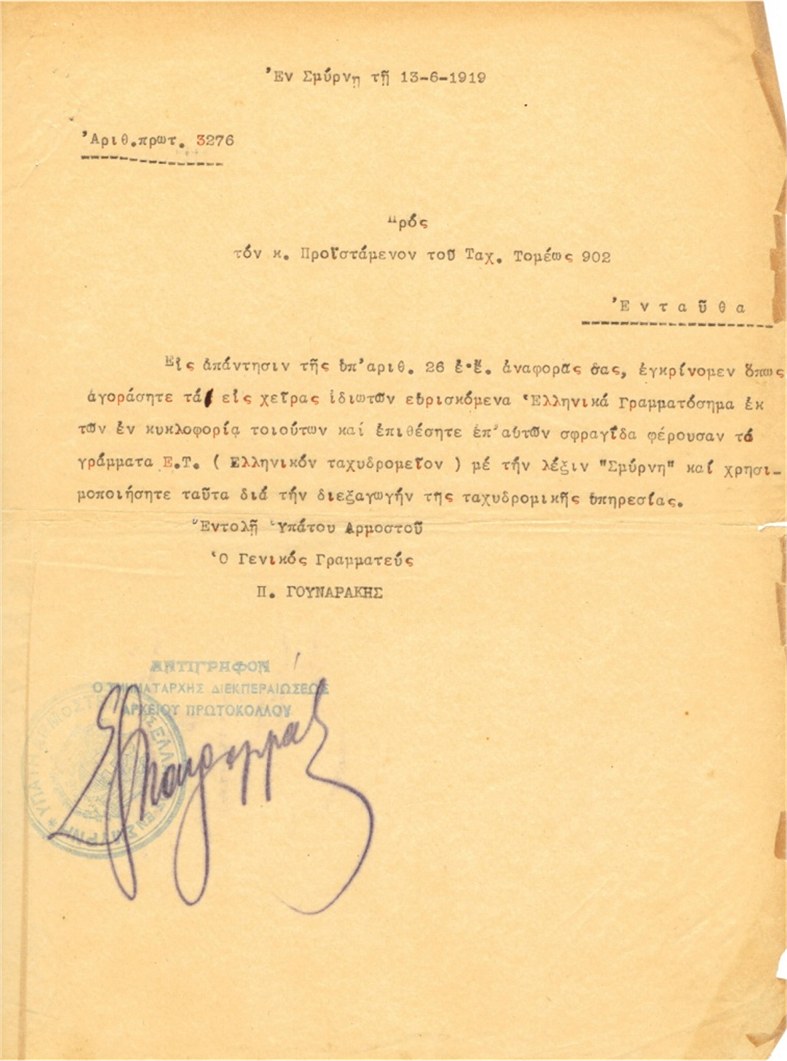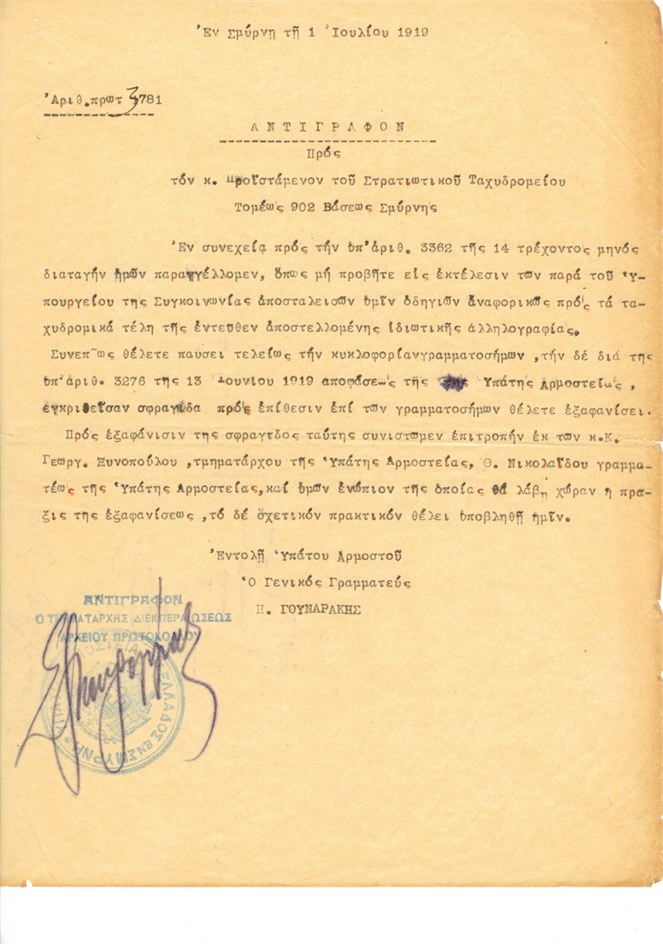27.09. 2025 … © ELIAS TEMPELIS
(updated – September 2025)
The relatively rich philatelic bibliography on the set of Greek stamps with the overprint «Ε.Τ. ΣΜΥΡΝΗ» [Greek Post Smyrna] first appeared in 1925, whilst fifty years later Charilaos Binos posed a set of questions, to the majority of which, to this day, conclusive answers cannot be easily given [1]. In fact, however, attention to this set of stamps was initially given by articles in four contemporary newspapers during the period October – November 1919, i.e. a few months after its short circulation, which lasted only one afternoon (13.6.1919).

What is initially presented in this article is a publication in the newspaper Hestia. Next follow two articles, from the author’s collection, which appeared newspapers Telegraphos and Valkanikos Tachydromos, together with an entry in the newspaper Stamboul [2]. Three official documents of the High Commission of Greece in Smyrna are also illustrated from the same collection, since the last two newspapers refer to their existence and content.
More specifically, the Athenian newspaper Hestia (no. 9019, 11.10.1919) presented this set of stamps exclusively as a case of profiteering by a businessman, which ended thanks to the immediate intervention of the High Commissioner Aristeidis Stergiadis (1861-1949), while the article also referred to his own assurance to the UPU in Bern that the Greek government does not recognise the overprint. The article reads as follows:
OCCUPATION STAMPS
When the Greek army landed in Smyrna and the authorities were established, a clever businessman acquired the most common Greek stamps, took them to a printing house, printed «Ε.Τ. Σμύρνη» on them, put them into circulation, and, just like a man who knows his job, sent some sets to the shops which sell stamps for collections and to the specialist newspapers. It goes without saying that the collectors fell like flies on this new fruit.
It just so happened, however, that Mr. Stergiadis learned about this and found this action more befitting of some small Republics in South America, rather than the dignity of the Greek State. He not only confiscated the overprinted stamps in circulation, but also notified the International Bureau in Bern that the Greek Government does not recognise the overprint.
This was the end of the business which had promised a considerable profit.
 A few days later in Smyrna, the newspaper Τelegraphos (no. 2825, 17.10.1919) reproduced verbatim with no comments the article in the Hestia after the following very brief introduction:
A few days later in Smyrna, the newspaper Τelegraphos (no. 2825, 17.10.1919) reproduced verbatim with no comments the article in the Hestia after the following very brief introduction:
OCCUPATION STAMPS
The newspaper “Hestia” of Athens refers to the following noteworthy aspects of the stamp collectors’ invasion.
In response to the Hestia, the Athenian newspaper Valkanikos Tachydromos (no. 577, 25.10.1919), which was supporting the Greek Prime Minister E. Venizelos, attempted to restore the truth, making clear that the overprinted set was indeed purchased at a very high price by collectors, as it happened in Paris, but its circulation was officially approved by the High Commission’s order no. 3276. Το confirm all this, the newspaper reported that the High Commission itself duly issued a new order for the prohibition of the circulation of the set, the incineration of the unsold stamps and the destruction of the seal of the overprint. Τhe article in the Valkanikos Tachydromos reads as follows:
ΤHE GREEK STAMPS OF SMYRNA
Our occupation in Smyrna caused a minor issue, which of course will not occupy the peace conference and the official diplomatic circles, but certain philatelic circles will not be left untouched by it!
On 13th June after permission by the Commission, the postal sector of the base issued and put into circulation nine of the lower values of our stamps with the overprint “Ε.Τ. [Greek Post] Σμύρνη”. They had been in circulation for no more than one afternoon, and only a few copies were bought by the directors of the foreign post offices there and some officers of the foreign fleet, when on the following day a new order prohibited their circulation and ordered the incineration of the unsold ones and the destruction of the seal of the overprint in the presence of a committee.
However, around seventy copies were in circulation. A few of them reached the hands of European dealers and today they are being sold in Paris for 4-5 thousand francs per set.
Since they were legitimately issued and were regularly in circulation through the post, commercially they have all properties so as to be sold, to be included in the foreign catalogues and, consequently, to be accepted in the international market.
Moreover, it is not strange that these few copies, which were in circulation, may reach the high prices of the first Rumanian stamps. The news that this set of stamps was not officially recognised is inaccurate, since this was issued following an official order (no. 3276) and was put into circulation through the post.
It should be noted that their nominal value is only …81 lepta! [3]
The reporter of the Valkanikos Tachydromos relayed the full truth as to the approving order, which was no. 3276/13.6.1919.  It should be clarified, however, that thereafter three different orders followed and not one, as is reported in the newspaper. More specifically, order no. 3362/14.6.1919 suspended the circulation of the set,
It should be clarified, however, that thereafter three different orders followed and not one, as is reported in the newspaper. More specifically, order no. 3362/14.6.1919 suspended the circulation of the set,
order no. 3781/1.7.1919 appointed a committee for the destruction of the seal of the overprint,
while for the incineration of the unsold quantities the High Commissioner gave a verbal order, which was finally executed well after the publication of the newspaper article, i.e. on 14.11.1919 [4].
Finally, as a reply to the articles in the Hestia and the Telegraphos,  the Italian nobleman and stamp dealer in Smyrna, Djalma Ricci, published an entry in the French speaking Constantinopolitan newspaper Stamboul (no. 268, 19.11.1919), aiming at reassuring his clients about the genuineness of the stamps which he had sold them. In order to support his claims, he translated the approving order into French and also made known that after his own intervention an official denial was expected concerning the article in the Hestia. The translation of Ricci’s entry is as follows:
the Italian nobleman and stamp dealer in Smyrna, Djalma Ricci, published an entry in the French speaking Constantinopolitan newspaper Stamboul (no. 268, 19.11.1919), aiming at reassuring his clients about the genuineness of the stamps which he had sold them. In order to support his claims, he translated the approving order into French and also made known that after his own intervention an official denial was expected concerning the article in the Hestia. The translation of Ricci’s entry is as follows:
Νotice to my customers
The newspaper Telegraphos of Smyrna dated 17/30 Οctober under the title “Occupation Stamps” reproduced an article, which appeared in the Hestia of Athens, according to which the stamps issued by the Greek Post in Smyrna are not official.
Ι notify my customers that I sold these stamps after having been made aware of the approving order for this issue, which I reproduce as follows:
High Commission of Greece in Smyrna
Protocol no. 3276.
Smyrna, 13-6-1919
To the Head of Postal Sector 902 Smyrna
In reply to your report no. 26 this year, we approve your purchase of the Greek stamps in circulation, which are found in the hands of civilians, and that you imprint on them the letters Ε.Τ. (Greek Post) together with the word ”Σμύρνη” and use them for the function of the postal service.
(Seal of the High Commission)
(Signature T.S.)
By order of the High Commissioner
The Secretary General
(Signed) Gounarakis
Furthermore, I asked the venerable High Commission of Greece in Smyrna [in relation to the article] which appeared in the Telegraphos, and I was assured that they will soon issue an official denial.
Smyrna, 10 Νοvember 1919
Djalma Ricci
Ascarli str. 2, Smyrna.
With this notice, which Ricci himself had signed on 10.11.1919, he attempted to reassure the philatelists who were his own customers, but most probably no official denial was issued by the High Commission. For its administration the issue was over when, on 14.11.1919, a report about the destruction of the unsold stamps was composed on its premises.
Therefore, it seems that, after the last entry, there was no more interest in this particular set of stamps on behalf of the contemporary newspapers, so the torch was picked up by the specialist authors.
Elias Tempelis
This article was taken with kind permission of the author from the Journal Philotelia, ISSN 0031-8264, issue 729, July – August 2021, pp. 226-234.
Editor’s note: Many interesting facts about the issue „GREEK SMYRNA 1919“ can be found in the article Smyrna – řecká okupace 1919. This article of mine was created thanks to information kindly provided to me by Mr. Elias Tempelis.
Endnotes:
[1] See, for instance, Athanassios Zervopoulos, “Τhe Greek stamps of Smyrna: The special issue (Study composed on the basis of official documents from the archive of the Commission in Smyrna)”, Philotelia nos. 16-18/1925, p. 35 ff.; Andreas Psaras, “Philatelic Encyclopedia: High prices of rare stamps. – The Ε.Τ. Σμύρνη set”, Τo Grammatosimon nos. 25-26/1944, p. 11-12; Charilaos M. Binos, “The Hellenic postal service in Asia Minor during the 1919-1922 campaign”, Μikrasiatika Chronika, vol. 16, 1975, p. 85-149; Rienk M. Feenstra, Greece – A collection of Forgeries, Postzegelvereniging Griekenland and the Netherlands, Publication nr. 4, 1993, 2nd ed. 1997, p. 122; Νeoklis Ζafeirakopoulos, “Non-existent cancellation Τ.Τ. 902 (Correction of a 1926 article)”, Philotelia no. 615/2002, p. 214-215; Michalis E. Tsirónis, “The counterfeit of the Ε.Τ ΣΜΥΡΝΗ overprint”, Fakes Forgeries Experts, no. 5/2002, p. 149-154.
[2] Vlastos auction no. 235, 15 May 2005, lot 2061.
[3] It is noted here that no document of the High Commission mentions any particular stamp values which were approved to be overprinted. Furthermore, according to Binos (op. cit., p. 108) and Vlastos catalogue the nominal value of a complete set is 1.06 drachmae, while according to the Hellas catalogue it is 96 lepta. For the exact number of values of this set, see also Tsirónis, op.cit.
[4] For the texts of the afore-mentioned orders, see Binos, op.cit., p. 111-112.
Publikováno pro nezávislý CZ/SK blog - www.znamkovezeme.cz
Přebírání obsahu jen s písemným souhlasem autora příspěvku !
--- Admin blogu ---



